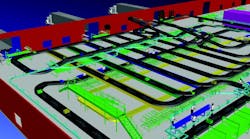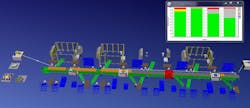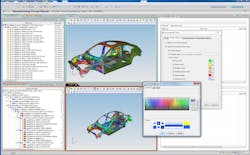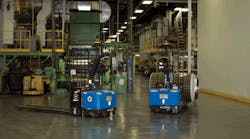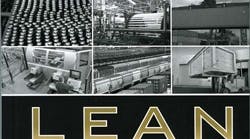Lean Manufacturing and IT systems do not often go together in many manufacturers’ and consultants’ minds. In fact, quite the opposite—a fundamental aspect of Lean’s approach to waste elimination is simplification and if the level of simplification that can be achieved means that IT is no longer required to manage a process, so much the better! At the level of simple internal processes or management of local assets, this is entirely possible.
Focusing on the use of space, movement of materials or product line flow more often than not yields impressive improvements in terms of eliminating material handling bottlenecks, reducing inventory or raising quality. But for the application of Lean thinking to deliver maximum benefit, it’s vital to assess the impact of such changes on the bigger picture—ultimately, the entire supply chain.
Good for One Not Always Good for All
First of all, there is the danger that “local” improvements fail to have any benefit at the overall plant level and beyond. For example, a bit of local efficiency improvement can easily cause problems at the plant or supply chain level by resulting in enlarged inventory build-up downstream.
Then there is the issue of time horizon—ensuring that a short term fix does not generate problems in the future. A common example is introducing efficiency but at the expense of flexibility—while in today’s economic climate, the high level of uncertainty in many markets is heightening the need for flexibility. Applying the principles of Lean Manufacturing to achieve greater, more sustainable benefits across the broader supply chain is a major challenge. And at this level, IT is an essential enabler.
One dimension of manufacturing supply chain scope is organizational/geographic reach. Many industries today comprise a lengthy and complex supply chain spanning a number of organizations in a number of countries, or perhaps a worldwide set of relationships more appropriately characterized as a supply network. Closely related to this is the dimension of “transaction life”—from initial delivery through in-use service to disposal. The goal is therefore to optimize the operational performance—speed of product flow, inventory levels, quality—across the whole network throughout each and every transaction lifecycle.
The other dimension of supply chain scope is of course the product lifecycle. The different stages of the product lifecycle are likely to involve different participants in different roles; for example, a development partner with advanced prototyping facilities would be likely to be replaced by a company with mass component production capabilities once the product was finalized.
An Integrated Web of Activities
Achieving improvement at the plant level requires the ability to span an integrated web of processes and practices. At the even broader supply chain level, this extends to inter-organizational processes. It is a Lean mantra that a huge proportion of manufacturing companies’ activities do not add value and are therefore comprising “waste” (although the extent of this is often exaggerated).
The activities that appear not to add value fall into two categories: those that really don’t and those that appear not to but actually do. The latter are often concerned with communication of information and are more opaque than tangible material movement or manufacturing process steps. Nevertheless, they can be critical and ensuring that they are retained and/or improved is a complex problem, especially at the inter-organization level, demanding an effective integrated IT environment.
Linking IT to Lean Thinking
The potential value of IT in driving Lean thinking starts at the early stage of the formation of the supply chain—in the product design activity itself. Examplesof obvious non-value adding activities are the creation of different versions of design information simply for the purpose of communicating changes to other members of the design network; or the inefficiencies involved in manually updating information in multiple places to reflect the latest design changes.
Integrationbetween design and manufacturing at the product development stage, now much greater than it was when the ‘over the wall’ problem was common, offers even greater possibilities. Current technology enables a digital version of the manufacturing facility to be tested in its entirety prior its physical creation. That is, not only the core manufacturing processes (machining, robotic operations etc.) but the entire manufacturing operation, including the materials handling and logistics aspects.
The result is a Lean practitioner’s dream; experimenting with the digital model enables the overall facility’s operation to be optimized and many problems that might have been addressed in practice (and let’s remember that some approaches to problem resolution encourage any operator to halt production when a problem is encountered, which, although effective, can be very expensive) to be fixed in the virtual world.
Enterprise Access to Product Data
Once in the market, optimizing the operational supply chain will almost always involve some combination of enterprise level solutions for finance/procurement (ERP), supply chain management (SCM), customer relationship management (CRM) and manufacturing execution systems (MES)—a veritable feast of acronyms. Common across all of these is the need to operate with the most current product information.
Inaccurate product data will result in errors in manufacturing processes, supply chain delays and ultimately errors in fulfilling customer requirements. Although thankfully rare, such problems are showcased by high profile major product recalls like that suffered by Toyota a couple of years ago. Accurate product information is also essential for responsive alternative sourcing, again the extreme example being the need for this in the wake of the supply disruptions caused by the Japanese tsunami. On a smaller scale, this kind of activity goes on all the time and is fundamental to maintain the supply chain’s responsiveness and profitability.
A single source of all relevant product information is the best way to keep the entire infrastructure aligned and for communicating changes in product specifications and requirements effectively throughout. Today, the issue of product information management is more complex than ever due to the ever-increasing software component of many products.
In general, software changes more rapidly than physical products and the increasing functional interdependence between software and their physical host devices is driving more rapid product change. The central role of the product information in determining the effectiveness of the overall IT infrastructure provides a strong case for arguing that the PLM component is the application that serves to bind the infrastructure together and is therefore critical to initiatives that reduce waste and improve performance.
Lean is the Universal Language
To achieve integration of all parties involved in the whole product life cycle, from ideas, through research to manufacturing and in-field support, the PLM environment must therefore be the lingua franca of the entire supply chain. It must provide the framework for managing the information requirements of a diverse group of collaborators—customers, design engineers, manufacturing engineers and operators, marketers and sales people. At the same time, it must do this efficiently—we are promoting Lean, after all.
For example, many companies collect more information about their operations than they really need, resulting in a waste of input effort. The PLM technology needs to assist companies to identify the useful information for product innovation and efficient yet flexible operations. It must also provide the means of embedding best practice wherever it can be applied.
We therefore arrive at quite a list of demands of PLM if it is to truly support the kind of improvement throughout the supply chain that Lean Manufacturing targets.
∙ We therefore want high levels of configurability and ease of use;
∙ We want it to impose discipline on the data and maintain rigorous version control;
∙ At the same time we want flexibility.
Lean Tools Getting Better
The PLM environment must of course support continuous improvement of processes throughout the supply chain, ideally providing timely visibility and even analysis of product and process trends. Integration with the complementary acronyms is a given.
The good news is that the leading PLM providers recognize all of this and have made substantial progress in recent years towards this set of goals.
Finally of course we want the PLM technology to be affordable. Here again, things have moved forward significantly, thanks to infrastructure and hardware developments like cloud computing and specialized processor developments.
Manufacturing networks are complex, dynamic environments and achieving supply chain and logistical improvement will always be a multi-faceted problem. The progression in the capabilities of the IT tools to support the effort presents opportunities but also new challenges. As they continue to get better and they become accessible to more companies globally, the performance bar will continue to move higher.
Success in manufacturing is going to require finding very smart ways to exploit the IT technologies for a lifecycle view of product development and for the right balance of efficiency and flexibility in the supply chain.
Tony Christian is director of Cambashi (www.cambashi.com), specialists in researching and analyzing the use of information technology in value-adding industries.
